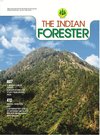Floristic Richness of Peddagattu-sherepally Area, a Proposed Site for Uranium Projects, Nalgonda District, Telangana State, India
DOI:
https://doi.org/10.36808/if/2018/v144i4/129326Keywords:
Generic Coefficient, Nalgonda, Species Richness, Uranium Projects.Abstract
The study was carried out in ordered to explore the existing floristic composition in Pedagattu- Sherepally area, Nalgonda district, Telangana state, which is a proposed site for uranium projects. The study area harbours 464 species under 324 genera and 86 families. Of the total 464 species, dicotyledons are represented by 373 species belonging to 258 genera under 70 families and 89 monocotyledon species belonging to 64 genera and 14 families. Habit wise analysis showed that herbs (239) most predominated species followed by shrubs (100), trees (89), aquatic forms (24) and climbers (12). The family Poaceae is the dominated family followed by Fabaceae, Asteraceae, Caesalpiniaceae, Euphorbiaceae and Acanthaceae. The present study collected a total 21 endemic species belonging to 19 genera and 12 families and total of 83 medicinal plant species belonging to 43 families and 73 genera were recorded. The proposed site for uranium projects coming to exist the flora of the study area would effect and altered.References
Connell J.H. (1978). Diversity in tropical rain forests and coral reefs. Science, 199: 1302-1303.
Duelli P. and Obrist M.K. (2003). Biodiversity indicators: the choice of values and measures. Agriculture Ecosystem and Environment, 98: 87-98.
Gamble J.S. and Fischer C.E.C. (1915-1935). Flora of the Presidency of Madras.
Gotelli N. and Colwell R.K. (2001). Quantifying biodiversity: Procedures and pitfalls in the measurement and comparison of species richness. Ecology Letters, 4: 379–391.
Gupta R. and Sarangi A.K. (2005). Emerging trend of Uranium mining: The Indian scenario. Presente in the IAEA symposium on ''Uranium production and raw materials for the nuclear fuel cyclesupply and demand, economics, the environment and energy securityâ€, Vienna, Jun., 20-24.
Hamilton A.J. (2005). Species diversity or biodiversity. J. Environmental Management, 75: 89–92.
Hurlbert S.H. (1971). The non concept of species diversity: a critique and alternative parameters. Ecology, 52: 577–586.
Leitner W. and Turner W.R. (2001). Measurement and analysis of biodiversity. In: Ecyclopedia of biodiversity (Levin S. A. ed.), Academic Press. Princeton, 4: 123-144.
Mac Arthur R.H. and Wilson E.O. (1967). The theory of island biogeography. Princeton University Press, Princeton.
Magurran A.E. (1988). Ecological diversity and its measurement. Chapman and Hall, London.
Magurran A.E. (2004). Measuring biological diversity. Blackwell Science Ltd.
McIntosh R.P. (1967). An index of diversity and the relation of certain concepts to diversity. Ecology, 48: 392–402.
Peet R.K. (1974). The measurement of species diversity. Annual Review of Ecology and Systematics, 5: 285-307.
Pullaiah T. Ramakrishnaiah V. Sadhya Rani S. and Rao P.N. (2000). Flora of Guntur district, Andhra Pradesh, India. Regency Publications.
Rao P.N., Swamy R. and Pullaiah T. (2001). Flora of Nalgonda district Andhra Pradesh. Shipra publication, Delhi.
Reddy S.C., Rao T., Siva Rama Krishna, I. and Javed S.M.M. (2008). Vegetation and Floristic studies in Nallamalais, Andhra Pradesh, India. J. Plant Science, 3 (1): 85-91.
Sarkar S. (2002). Defining Biodiversity. Assessing Biodiversity. The Monist, 85: 131-155.
Simpson G.G. (1964). Species density of North American recent mammals. Systematic Zoology, 13: 57-73.
Stevens G.C. (1989). The latitudinal gradient in geographical range: how so many species coexist in the tropics. American Naturalist, 133: 240-256.
Thothathri K. (1964). The Flora of the Nagarjunakonda Valley and surrounding hills. Indian Forester, 90: 539-546.
Downloads
Downloads
Published
How to Cite
Issue
Section
License
Unless otherwise stated, copyright or similar rights in all materials presented on the site, including graphical images, are owned by Indian Forester.





